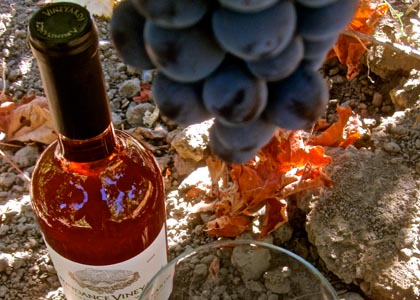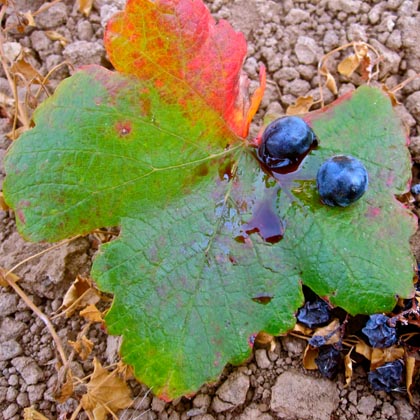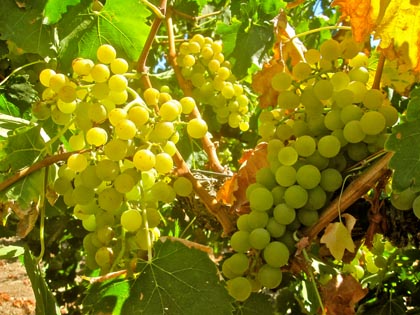Letters from Lodi
An insightful and objective look at viticulture and winemaking from the Lodi
Appellation and the growers and vintners behind these crafts. Told from the
perspective of multi-award winning wine journalist, Randy Caparoso.
Wine 101: color & taste sensations
The color in pink wines comes from brief skin contact with skins of black grapes...
How wines get their color
The pigmentation of wines comes from the skins of grapes they’re made from. White wines are usually produced from light, green skinned grapes, and red wines from dark, black skinned grapes. The actual juice of most varieties of vinifera is colorless. Therefore, it is entirely possible to make a pink or even pale white colored wine from a black skinned grape simply by separating the skins from the juice immediately after picking, prior to fermentation.
The finest, clear colored sparkling wines, for example, come from Champagne in France, most of which is made from the black skinned Pinot Noir grape, in combination with the green skinned Chardonnay grape. Or, to make a pink or rosé colored wine, the juice of black grapes are allowed a brief period of contact with the skins – hence, “White Zinfandel,” which many Americans still love to drink.
Although there is little pigmentation in white wine grapes like Chardonnay and Sauvignon Blanc, vintners typically separate the skins from the juice as soon as possible after picking in order to avoid getting the bitter or astringent taste of tannin, the phenolic component that is also found in the skins of grapes, as well as in the seeds and stems. Tannin can enhance a red wine, but white wines are not considered so good when they have the bitter taste of tannin. You want white wines to taste smooth and fresh, not hard or astringent.
Lodi grows extensive acreage of Alicante Bouschet, one of the few vinifera varieties with white rather than red colored juice
It’s a different matter when it comes to producing red wine. In order to make reds with the richest possible color and flavor extraction, vintners ferment black skinned grapes fully intact: grapes, and sometimes whole clusters, are “crushed” (or better yet, gently squooshed), and everything — skins, seeds, and sometimes even stems — goes into the vats to ferment. The thicker the skin, usually the richer the color. The darkest, richest and fullest red wines are made from deeply pigmented, thick skinned grapes such as Cabernet Sauvignon, Merlot, Syrah and Petite Sirah. Pinot Noir, on the other hand, is characteristically thinner skinned, and thus, ending up as lighter colored, softer tannin, more delicate styles of red wines than Cabernet Sauvignon, Merlot or Syrah.
While not as delicate as Pinot Noir, skins of the Zinfandel grape are actually fairly thin in comparison to the thicker skinned varieties. However, one of the characteristics of Zinfandel is that it grows and ripens uneven sized berries — “hens and chicks,” as growers often describe them. Therefore, with many of the smaller berries in typical Zinfandel clusters having higher skin to juice ratios, Zinfandels usually end up as red wines that are quite dark — vivid purplish rubies — and also sturdy in tannin, plus lots of fruitfulness, since most of every wine’s flavor, directly related to aromatic qualities, is also derived from compounds originating in the skins.
Don't try this at home, kids: Lodi's Markus Bokisch drinking from a porron (Spanish wine pitcher)
What are the basic taste sensations?
The human tongue is able to detect four different taste sensations:
- Sweetness (or in absence of residual sugar, “dryness” in a wine)
- Sourness (tart sensations derived from acidity)
- Bitterness (primarily derived from grape tannins)
- Saltiness (not a factor in the taste of wines, but certainly a factor in foods and how wines interact with salty ingredients).
The important thing to understand about taste sensations is that the choice of grape type is the major determining factor, starting with black skinned grapes vs. green skinned grapes. Red wines are made from black grapes fermented with the skins and seeds, and therefore tend to have a heavier, drier taste than white wines. To make white wines, the juice of grapes are separated from the skins before fermentation, resulting in a softer, lighter taste sensations.
Certain white wine grapes, such as Riesling and Muscat (often called Moscato), are often finished with a good percentage of unfermented residual sugar, and therefore are almost always sweeter than wines made from white wine grapes such as Chardonnay and Sauvignon Blanc, which are traditionally fermented completely dry.
Certain white wine grapes tend to be higher in acidity than other white wine grapes, and therefore are typically more tart, or “crisp,” in quality. Sauvignon Blanc, for instance, is almost always a higher acid grape than Chardonnay; and so are Albariño and Riesling (although you many not notice the tartness of fairly sweet Rieslings, since their residual sugar often masks the higher acidity).
Understanding differences in basic taste sensations becomes even more important when thinking about food. A lemony crisp Sauvignon Blanc or Albariño, for instance, are more natural wine matches with foods that benefit from tart ingredients (like raw oysters and other shellfish); whereas a lower acid, soft, round Chardonnay is an easier match with dishes like fish or chicken in slightly oily, buttery sauces. We will talk more about how varietal taste sensations effect the sensations of foods in a future post.
Our next wine 101: The origin of flavor and the effect of tannin
The rare Moscato Giallo, grown by Lodi's Kevin Delu for Uvaggio



